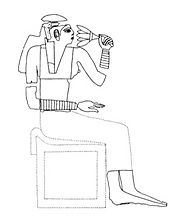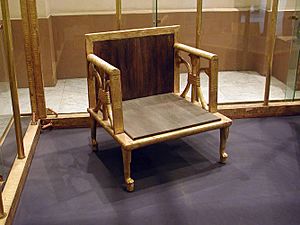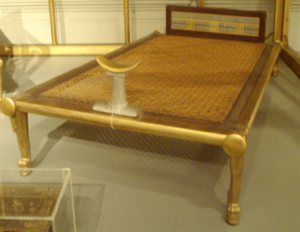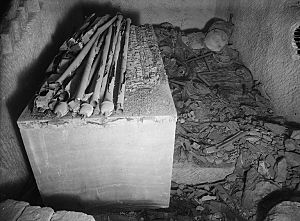Hetepheres I facts for kids
Quick facts for kids Hetepheres I |
|
|---|---|
| Queen of Egypt | |

Gold figure of Hetepheres from her Giza tomb - drawing by George Reisner (1925)
|
|
| Burial | Tomb G 7000X near the Great Pyramid of Giza |
| Spouse | Sneferu |
| Issue | Hetepheres Khufu |
| Father | Huni |
| Religion | Ancient Egyptian religion |
Hetepheres I was an important queen in ancient Egypt. She lived during the Fourth Dynasty of Egypt, around 2600 BC. She was the wife of one king, the mother of the next king, and the grandmother of two more kings. This made her a very important link between different royal families.
Contents
The Life of Queen Hetepheres
Hetepheres I was likely a wife of King Sneferu. She was also the mother of King Khufu, who built the Great Pyramid at Giza. It's thought that Hetepheres might have been a less important wife at first. But she became very powerful after her son, Khufu, became king.
She was also the grandmother of two kings, Djedefre and Khafre. Her granddaughter was also named Hetepheres II.
Queen Hetepheres had several important titles:
- King's Mother (Mut-nisut): This meant she was the mother of the king.
- Mother of the King of the Two Lands (Mut-nisut-biti): This title showed she was the mother of the ruler of both Upper and Lower Egypt.
- Attendant of Horus (Khet-heru): This linked her to the important Egyptian god Horus.
- God's Daughter of his body (Zat-netjer-net-khetef): This special title meant she was the daughter of a god. Her father, Huni, who ruled before Sneferu, was considered a god after his death.
Her marriage to King Sneferu was very important. It helped to connect two powerful royal families. This was because Hetepheres carried the royal bloodline from her family to Sneferu's. The mothers of Egyptian kings had a very special place in society. Her later titles showed how important her relationship was to her son, King Khufu. Khufu was the one who ordered her tomb and pyramid to be built.
Finding the Queen's Tomb
In 1902, a team from Harvard University and the Museum of Fine Arts, Boston began digging at Giza. For 23 years, they carefully explored and recorded the area.
On March 9, 1925, something amazing happened. The team's photographer noticed a patch of plaster where he expected to see stone. The expedition leader, George Andrew Reisner, was away in the USA. So, Ahmed Said, Reisner's head worker, led the team. They removed the plaster and found a deep shaft, like a well. They dug down 85 feet (about 26 meters) before they hit a stone wall.
When they broke through the wall, they found a jumble of grave goods. These included a white stone sarcophagus, gold-covered poles from a canopy, gold, wooden furniture, and more. A team member, Battiscombe Gunn, used binoculars and mirrors to look inside. He saw an inscription that mentioned Sneferu. At first, people thought this meant the tomb belonged to Sneferu. But it only meant the tomb's owner lived during his rule.
Reisner believed that this was a secret reburial. He thought robbers had broken into the queen's first tomb. By April, he figured out that the tomb belonged to Hetepheres. She was Sneferu's wife and Khufu's mother. In 1927, the team finally opened the sarcophagus. To their surprise, it was empty!
The Mystery of the Empty Tomb
The empty sarcophagus led to many ideas about what happened.
- Reisner's Idea: George Reisner thought Hetepheres was first buried near her husband's pyramid in Dahshur. He believed robbers broke into her tomb soon after her burial. They stole her mummy and all its gold jewelry. But they left before taking the other treasures. Reisner thought the officials in charge of the tomb were afraid of the king's anger. So, they told Khufu that his mother's mummy was still safe inside the sarcophagus. Khufu then ordered the sarcophagus and treasures to be reburied at Giza, near his own pyramid.
- Mark Lehner's Idea: Dr. Mark Lehner has a different idea. He thinks G 7000X (the tomb found) was Hetepheres's first tomb. He believes her second tomb was Pyramid G1-a, one of the small pyramids near Khufu's. He thought the queen's mummy was moved from G 7000X when the pyramid was finished. Some grave goods were left behind when she was reburied.
- Other Ideas: Another idea is that G 7000X was always meant to be her final resting place. The mummy might have been stolen from there soon after her burial. Dr. Zahi Hawass thinks Hetepheres was first buried at G1-a. After a robbery there, a new shaft was dug for a new tomb. This could explain why some of the tomb objects looked like they had been tampered with.
The exact story of her burial remains a mystery.
Treasures from the Tomb


The sarcophagus and the queen's funeral furniture were found in 1925. This was in shaft G 7000X, a pit tomb near the Great Pyramid of Giza. Even though the sarcophagus was sealed, and the Canopic chest was untouched, Hetepheres's mummy was gone.
The canopic chest is a large square box with four smaller sections inside. It's one of the oldest examples ever found. This suggests Hetepheres might have been one of the first Egyptian royals to have her organs preserved. All four inner sections contained some organic material. Two of them also had a liquid. Tests showed this liquid was a special salt solution used in mummification.
The items found in the tomb tell us a lot about the rich and luxurious lives of the royal family during the Fourth Dynasty of Egypt. These amazing items are now on display at the Egyptian Museum in Cairo. You can also see copies of the main furniture pieces at the Museum of Fine Arts, Boston.
Here are some of the treasures found in Hetepheres's tomb:
- Bed canopy: This was covered in gold and had inscriptions. King Sneferu gave it to her.
- Bed with inlaid footboard: Also covered in gold.
- Curtain box: Covered in gold and decorated with colorful faience (a type of glazed pottery). It had inscriptions and showed the king seated.
- Armchair with papyrus flower decoration: Covered in gold.
- Another armchair: Decorated with images of the goddess Neith and hawks.
- Gold fragments: Likely from a small box lid, showing the queen smelling a lotus flower.
- Palanquins: These were special chairs carried by servants. They were covered in gold and had inscriptions.
- Leather case remains: This held two long staffs covered in gold and a wooden stick with decorations of the god Min.
- Chest: Covered in gold with a decorated lid. It held a box with eight inscribed alabaster (a type of stone) ointment jars. It also had a copper toilet-spoon, a gold-covered box with silver bracelets shaped like butterflies, and a wooden head-rest covered in gold and silver.
- Sarcophagus: Made of alabaster.
- Canopic box: Also made of alabaster.
See also
 In Spanish: Hetepheres I para niños
In Spanish: Hetepheres I para niños
- Egyptian Fourth Dynasty Family Tree


